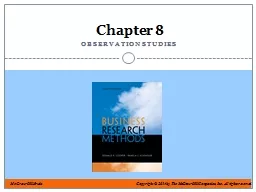

Chapter 8 Learning Objectives Understand When observation studies are most useful Distinctions between monitoring nonbehavioral and behavioral activities Strengths of the observation approach in research design ID: 278695
Download Presentation The PPT/PDF document "Observation Studies" is the property of its rightful owner. Permission is granted to download and print the materials on this web site for personal, non-commercial use only, and to display it on your personal computer provided you do not modify the materials and that you retain all copyright notices contained in the materials. By downloading content from our website, you accept the terms of this agreement.
Slide1
Observation Studies
Chapter 8Slide2
Learning Objectives
Understand . . .
When observation studies are most useful.
Distinctions between monitoring.
nonbehavioral
and behavioral activities
Strengths of the observation approach in research design.
Weaknesses of the observation
approach in
research design.Slide3
Learning Objectives
Understand . . .
Three perspectives from which the observer- participant relationship may be viewed.
Various designs of observation studies.Slide4
Pull Quote
“Today, scores of built-in sensors in Formula One cars continuously capture a multiplicity of variables—including RPMS, weather, road conditions, the angles on a track’s s-bends, wear on tires, to pit stop now or next lap—and process it into data for active simulation models that inform a drivers’ instantaneous decisions. Formula One racing today is as much about deriving Continuous Intelligence and decision-making as it is about engine speed and driving expertise.”
John Chen
,
CEO,
SybaseSlide5
Observation and the Research ProcessSlide6
Selecting the Data Collection MethodSlide7
Selecting an Observation Data Collection ApproachSlide8
Research Design
How?
Where?
Task Details
What?
(event or time)
When?
Who?Slide9
Content of Observation
Factual
Inferential
Introduction/identification of salesperson and customer.
Credibility of salesperson. Qualified status of customer.
Time and day of week.
Convenience for the customer. Welcoming attitude of the customer
Product presented.
Customer interest in product.
Selling points presented per product.
Customer acceptance of selling points of product.
Number of customer objections raised per product.
Customer concerns about features and benefits.
Salesperson’s rebuttal of objection.
Effectiveness of salesperson’s rebuttal attempts.
Salesperson’s attempt to restore controls.
Effectiveness of salesperson’s control attempt.
Consequences for customer who prefers interaction.
Length of interview.
Customer’s/salesperson’s degree of enthusiasm for the interview.
Environmental factors interfering with the interview.
Level of distraction for the customer.
Customer purchase decision.
General evaluation of sale presentation skill.Slide10
Data Collection
Watching
Listening
Touching
Smelling
ReadingSlide11
Using Observation
Systematic planning
Properly controlled
Consistently dependable
Accurate account of eventsSlide12
Observation Classification
Nonbehavioral
Physical condition analysis
Process or Activity analysis
Record analysis
Behavioral
Nonverbal
Linguistic
Extralinguistic
SpatialSlide13
Selecting an Observation Data Collection Approach:
NonbehavioralSlide14
Nonbehavioral Observation
Record
Analysis
Physical Condition
Analysis
Physical Process
AnalysisSlide15
Selecting an Observation Data Collection Approach: BehavioralSlide16
Behavioral Observation
“We noticed people scraping the toppings off our pizza crusts. We thought at first there was something wrong, but they said, ‘We love it, we just don’t eat the crust anymore.”
Tom Santor,
Donatos PizzaSlide17
Systematic Observation
Encoding observation information
Structured
Systematic
Trained observers
Standardized procedures
Recording schedulesSlide18
Flowchart:Observation Checklist DesignSlide19
Mechanical/Digital Behavioral Observation
Eye camera
Pupilometer
Devices
Audio recorder
Video camera
Galvanometer
TachistoscopeSlide20
Observer-Participant Relationship
Direct vs. indirect
Known vs. unknown
Involved vs. uninvolved Slide21
Extralinguistic Observation
Vocal
Temporal
Interaction
Verbal StylisticSlide22
Desired Characteristics for Observers
Concentration
Detail-oriented
Unobtrusive
Experience levelSlide23
Errors Introduced by Observers
Observer Drift
Halo EffectSlide24
Evaluation of Behavioral Observation
Strengths
Securing information that is otherwise unavailable
Avoiding participant filtering/ forgetting
Securing environmental context
Optimizing naturalness
Reducing obtrusiveness
Weaknesses
Enduring long periods
Incurring higher expenses
Having lower reliability of inferences
Quantifying data
Keeping large records
Being limited on knowledge of cognitive processesSlide25
Key Terms
Concealment
Event sampling
Halo effect
Observation
Direct
Extralinguistic
Indirect
Linguistic
Nonverbal
Participant
Simple
Spatial
SystematicSlide26
Key Terms
Observation checklist
Observer drift
Physical condition analysis
Physical trace
Process (activity) analysis
Reactivity response
Record analysis
Spatial Relationships
Time sampling
Unobtrusive measuresSlide27
Additional Discussion opportunities
Chapter 8Slide28
Research Thought Leader
“Once a pattern becomes predictable, the
brain starts to ignore it. We get bored;
attention is a scare resource, so why waste
it on something that’s perfectly predictable.”
Jonah Lehrer
neuroscientist and author,
How We DecideSlide29
PulsePoint: Research Revelation
3
The number of minutes the average cubicle dweller works before being interrupted by phone, e-mail, instant message, or social networking activities.Slide30
PicProfile: BestBuy Redesign
Store associates as observers
Eastern European ship workers as subjects
Display relocation
Increased
salesSlide31
Snapshot: Cutting Edge or Black Box
Neuroimaging techniques
Better conceptual understanding of latent constructs of behavior
PET scan
Magnetic resonance imagingSlide32
Snapshot: Wal-Mart Implements RFID Labels
“
We can certainly understand and
appreciate consumer
concern about privacy. That’s why
we want
our customers to know that RFID tags
will not
contain nor collect any additional data
about our
customers. In fact in the foreseeable
future, there
won’t even be any RFID readers on
our stores
’ main sales floors.”
Linda
Dillman
EVP & Chief Information Officer
Wal-MartSlide33
Snapshot: Eyes Have It
Understand peoples’ reactions to stimuli
Reveal the see-say gap
Calibrated to your computer
Anything presented on screen can be tested
No lab neededSlide34
Snapshot: Physicians and Patients
Reveal core emotional experiences
Reveal motivations for parents’ decisions
Video & audio observation
Respect sensitivity of subject & environment
Obtain parent consentSlide35
Lexus Observation at AutoshowSlide36
SizeUSA
Body Measurement SystemSlide37
Portable People MetersSlide38
Extralinguistic Observation
Vocal
Temporal
Interaction
Verbal StylisticSlide39
Observation Studies
Chapter 8Slide40
Photo Attributions
Slide
Source
35
Courtesy of Lexus; Ingram Publishing
10
Rob MeInychuk/Getty Images
11
Blend Images/John Lund/Getty Images
16
Torok-Bognar Renata/Getty Images
20
©MBI/Alamy
21
McGraw-Hill Companies, Inc./Jill
Braaten
, photographer
22
Courtesy of Akron Children's Hospital and Marcus Thomas LLC
Slide
Source
30
Digital Vision/
Punchstock
31
Courtesy of the National Institutes of Health
33
Nick
Koudis
/Getty Images
34
©LWA/
Dann
Tardif/Blend Images/Corbis
35
Courtesy of Lexus; Ingram Publishing
38
National Archives and Records Administration (NLS-WHPO-A-C584 (12))